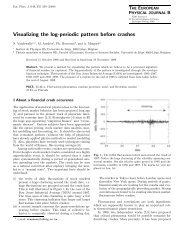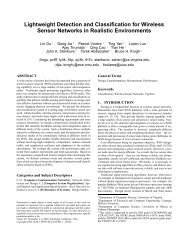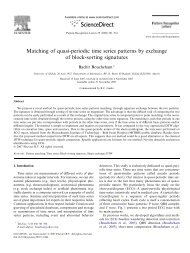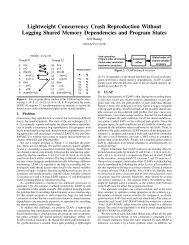Practical Advertisement Detection in Video
Practical Advertisement Detection in Video
Practical Advertisement Detection in Video
Create successful ePaper yourself
Turn your PDF publications into a flip-book with our unique Google optimized e-Paper software.
<strong>Practical</strong> <strong>Advertisement</strong> <strong>Detection</strong> <strong>in</strong> <strong>Video</strong><br />
1. Background<br />
Usually there are many advertisements <strong>in</strong><br />
television. This is not efficient for video<br />
record<strong>in</strong>g as the advertisement part takes a<br />
lot of extra space for storage. It is very good<br />
if all the advertisements can be removed <strong>in</strong><br />
televisions video record<strong>in</strong>g and storage<br />
automatically. Therefore, it is good for us to<br />
design a method to identify the<br />
advertisement parts <strong>in</strong> TV streams.<br />
2. Types of video clip<br />
We classify video segments <strong>in</strong>to the<br />
follow<strong>in</strong>g three types.<br />
Movies: These usually last for<br />
approximately 15 m<strong>in</strong>utes each time, 4 times<br />
per hour. We should m<strong>in</strong>imize the number<br />
of news/movies that wrongly detected as<br />
advertisements.<br />
Connections: There are typically several<br />
seconds of video connect<strong>in</strong>g the<br />
advertisement part and news/movies part.<br />
This part is very useful and will be expanded<br />
further <strong>in</strong> the follow<strong>in</strong>g sections.<br />
<strong>Advertisement</strong>s: These usually last for 3-4<br />
m<strong>in</strong>utes each time, 4 times per hour. We<br />
should maximize the number of extracted<br />
advertisements.<br />
3. Repetition of advertisement<br />
Here we use movie data from observations<br />
of “Hong Kong free-to-air TV”. It is not rare<br />
to see an advertisement appear<strong>in</strong>g more than<br />
one time dur<strong>in</strong>g the course of a movie, but<br />
there are few movie segments that appear<br />
exactly the same. Hence we can detect<br />
advertisements that have repetition<br />
throughout hours of videos. Here we divide<br />
advertisement <strong>in</strong>to two subtypes:<br />
advertisements that have repetition <strong>in</strong> a<br />
Du,Jiaen (taokayan13@gmail.com)<br />
video, nam<strong>in</strong>g repetitive advertisements,<br />
and advertisements that have no repetition <strong>in</strong><br />
a video, nam<strong>in</strong>g non-repetitive<br />
advertisements. In this project, we devised<br />
our algorithm for fast frame search and<br />
detection of advertisements and connections.<br />
4. <strong>Practical</strong> advertisement detection<br />
4.1. <strong>Detection</strong> of repetitive advertisements<br />
and connections<br />
For a video, usually there are about 25<br />
frames per second. Although movies with<br />
different fps exist, it would not affect the<br />
basic idea of our algorithm. For 3 hours of<br />
video, the number of frames rapidly become<br />
25 x 60 x 60 x 3 = 270,000. Search<strong>in</strong>g two<br />
similar frames by brute-force would cost<br />
73,000,000,000 frames comparisons which<br />
is totally unacceptable. To elim<strong>in</strong>ate the<br />
number of computation, we hash every<br />
frame <strong>in</strong>to the hash table.<br />
frames <strong>in</strong> video<br />
Hash Hash Hash<br />
<strong>Video</strong> Time<br />
Hash Table<br />
Figure 1, hash<strong>in</strong>g the whole video<br />
The way we devise the hash value of one<br />
frame is: we select four different regions<br />
with fixed positions and sizes, comput<strong>in</strong>g<br />
the gray level of each region. Then we<br />
normalize each gray level <strong>in</strong>to 0,<br />
1. Here we choose levelmax =<br />
32 = 2 , us<strong>in</strong>g 5 bits of space to store one
gray level. Comb<strong>in</strong><strong>in</strong>g 4 gray levels we<br />
f<strong>in</strong>ally get a hash value.<br />
0 15 <br />
1 10<br />
2 5<br />
3<br />
graylevel(0) graylevel(1) graylevel(2) graylevel(3)<br />
After do<strong>in</strong>g hash<strong>in</strong>g, similar frames appear<br />
<strong>in</strong> the same hash values.<br />
… HashValue0 HashValue1 …<br />
Frame(t0)<br />
Frame(t1)<br />
Frame(t2)<br />
20-bit hash value<br />
Sub Region<br />
Screen<br />
5 bits<br />
Figure 2, hash value of a frame<br />
Hash Table<br />
conta<strong>in</strong><strong>in</strong>g all<br />
frames <strong>in</strong> a video<br />
Similar frames with same<br />
hash values <strong>in</strong> time t0, t1,<br />
t2…<br />
Figure 3, Similar Frames <strong>in</strong> same hash slot<br />
Although similar frames will have the same<br />
hash value, it is not guarantee that any two<br />
frames <strong>in</strong> the same hash slot will be similar.<br />
Hash value can only reduce the<br />
computational complexity but how far we<br />
can improve our performance by us<strong>in</strong>g<br />
frame hash<strong>in</strong>g totally depends on how good<br />
we devise our hash function. The best hash<br />
function should uniformly distribute all<br />
frames <strong>in</strong>to different hash values.<br />
For every two frames with the same hash<br />
value at time t0, t1 respectively, nam<strong>in</strong>g<br />
frame(t0), frame(t1), we aim to f<strong>in</strong>d the two<br />
similar video <strong>in</strong>tervals that conta<strong>in</strong> t0 and t1<br />
respectively. To detect whether two frames<br />
are similar or not, we have devised the<br />
follow<strong>in</strong>g frame similarity calculation<br />
method:<br />
1). Divide the bitmap of the frame at time t<br />
<strong>in</strong>to sub blocks. The more sub blocks we<br />
divide <strong>in</strong>to, the more accuracy of image<br />
comparison we get, but also the more<br />
computational time and disk storage are<br />
required. To compromise time complexity<br />
are accuracy, we use 12 x 9 sub blocks to<br />
represent a frame, as most advertisements<br />
are at ratio of 4:3. Then we calculate<br />
average red, green, blue color of each block<br />
respectively; Denote them as red(t,i),<br />
green(t,i), blue(t,i) where t stands for the<br />
time of the frame and i is for block <strong>in</strong>dex.<br />
2).For two frames at time t1 and t2,<br />
similarity is def<strong>in</strong>ed as follow:<br />
1, 2<br />
∑1, 2, <br />
1 <br />
255 12 9<br />
∑1, 2, <br />
<br />
<br />
255 12 9<br />
∑1, 2, <br />
255 <br />
12 9<br />
, , are weights of red, green, blue<br />
respectively, which satisfy 1;<br />
values of red, green, blue range from 0 to<br />
255.<br />
F<strong>in</strong>d<strong>in</strong>g two similar video <strong>in</strong>tervals via<br />
similarity calculation:<br />
We set a threshold of determ<strong>in</strong><strong>in</strong>g whether<br />
two frames are similar:<br />
- If Similarity(t1,t2) >=<br />
similarity_threshold, frame(t1) and<br />
frame(t2) are similar.
- If Similarity(t1,t2) <<br />
similarity_threshold, frame(t1) and<br />
frame(t2) are not similar<br />
In practice, we set similarity_threshold =<br />
0.999<br />
We start compar<strong>in</strong>g frames t0 and t1, then<br />
t0+1 and t1+1 , then t0+2 and t1+2,…,<br />
until two frames are no longer similar. Then<br />
we get a pair of similar segments 0 , 0 <br />
∆ , 1 , 1 ∆ .<br />
Aga<strong>in</strong>, we compare frames t0-1 and t1-1,<br />
then t0-2 and t1-2 until two frames are no<br />
longer similar. 0 ∆ , 0, 1 <br />
∆ , 1.<br />
Comb<strong>in</strong><strong>in</strong>g the former results we have a pair<br />
of similar segments 0 ∆ , 0 <br />
∆ , 1 ∆ , 1 ∆ .<br />
The follow<strong>in</strong>g graph illustrates our<br />
calculation.<br />
… HashValue0 HashValue1 …<br />
Frame(t0)<br />
Frame(t1)<br />
Similarity<br />
Calculation<br />
… frame(t0) frame(t0+1) …<br />
Similarity<br />
Calculation<br />
Similarity<br />
Calculation<br />
Figure 4, Search<strong>in</strong>g Similar video <strong>in</strong>tervals<br />
Once we have the two similar video<br />
segments<br />
0 ∆ , 0 ∆ , 1 <br />
∆ , 1 ∆ , we have f<strong>in</strong>d one<br />
…<br />
… frame(t1) frame(t1+1) …<br />
Hash Table<br />
<strong>Video</strong> Time<br />
Similarity<br />
Calculation<br />
<strong>Video</strong> Time<br />
pair of video repetition of length ∆ <br />
∆ start<strong>in</strong>g at time 0 ∆ ,<br />
1 ∆ respectively. To further<br />
deduce what type these two video segments<br />
belong to, we use the follow<strong>in</strong>g criteria:<br />
- If ∆ ∆ <br />
___,<br />
they belong to noth<strong>in</strong>g, ignore them<br />
- If ∆ ∆ <br />
___,<br />
they belong to advertisements or<br />
connections<br />
In this project, we set the value of<br />
___ to be 6<br />
sec.<br />
4.2. <strong>Detection</strong> of non-repetitive<br />
advertisements<br />
<strong>Advertisement</strong>s that have no repetition will<br />
be more difficult to detect. Only ignore<br />
those advertisements will let the result<br />
accuracy drop dramatically. To detect this<br />
type of advertisement, we use the everyday<br />
knowledge that, each advertisement section<br />
<strong>in</strong> a video will last for 3-4 m<strong>in</strong>utes <strong>in</strong>side<br />
which are all advertisements. Further more,<br />
if two advertisements have been detected<br />
us<strong>in</strong>g previous repetition search<strong>in</strong>g methods,<br />
and if those two advertisements happen<br />
with<strong>in</strong> a 3-4 m<strong>in</strong>ute time slot, we can<br />
conclude that all video frames between those<br />
two advertisements should also belong to<br />
advertisement part. (Illustrated <strong>in</strong> the<br />
follow<strong>in</strong>g graph)<br />
Detected repetitive advertisements/connections<br />
Concluded non-repetitive <strong>Advertisement</strong>s<br />
<strong>Video</strong> Time<br />
Figure 5, <strong>Detection</strong> of non-repetitive advertisements
We set a threshold __,<br />
represent<strong>in</strong>g the maximum time <strong>in</strong>terval of<br />
consecutive advertisements. We conclude a<br />
time <strong>in</strong>terval to be a non-repetitive<br />
advertisement time <strong>in</strong>terval if:<br />
- Length of <strong>in</strong>terval <<br />
__<br />
- There is a repetitive<br />
advertisement/connection right<br />
before the <strong>in</strong>terval<br />
- There is a repetitive<br />
advertisement/connection right after<br />
the <strong>in</strong>terval.<br />
In practice, we set __to be 200<br />
seconds.<br />
5. Tests and Results<br />
Movie A<br />
Source: Pearl Channel, TVB, HK<br />
Length: 3 hours 45 m<strong>in</strong>utes<br />
Test Setup:<br />
Test 1 First 45 m<strong>in</strong>utes of movie A<br />
Test 2 First 1 hour of movie A<br />
Test 3 First 1 hour 45 m<strong>in</strong>utes of movie A<br />
Test 4 First 2 hours 35 m<strong>in</strong>utes of movie A<br />
Test 5 The whole movie A<br />
System Configuration:<br />
W<strong>in</strong>dows XP SP2;<br />
AMD Athlon64x2 TK-57 at 2300MHz<br />
Integrated Geforce 7150 / nForce 630M<br />
1G RAM<br />
120G Hard disk.<br />
Test Results<br />
Test<br />
Length<br />
of<br />
detected<br />
ads.<br />
Length<br />
of actual<br />
ads.<br />
Test<br />
1 2<br />
0 4<br />
m<strong>in</strong>s<br />
45<br />
secs<br />
10 14<br />
m<strong>in</strong>s m<strong>in</strong>s<br />
32 2<br />
secs secs<br />
Test<br />
3<br />
17<br />
m<strong>in</strong>s<br />
10<br />
secs<br />
26<br />
m<strong>in</strong>s<br />
37<br />
secs<br />
Test<br />
4<br />
29<br />
m<strong>in</strong>s<br />
44<br />
secs<br />
37<br />
m<strong>in</strong>s<br />
57<br />
secs<br />
Test<br />
5<br />
46<br />
m<strong>in</strong>s<br />
13<br />
secs<br />
54<br />
m<strong>in</strong>s<br />
24<br />
secs<br />
Length<br />
of false<br />
detection<br />
0 0 0 0 0<br />
Precision ## 100% 100% 100% 100%<br />
Recall 0% 34% 64% 78% 85%<br />
100<br />
90<br />
80<br />
70<br />
60<br />
50<br />
40<br />
30<br />
20<br />
10<br />
0<br />
6. Conclusions<br />
This method works <strong>in</strong> the situation that<br />
advertisement repetition exists. Nonrepetitive<br />
advertisements can be estimated <strong>in</strong><br />
the knowledge of detected repetitive<br />
advertisements. If more videos are analyzed,<br />
the number of repetitive advertisement will<br />
<strong>in</strong>crease, while the number of non-repetitive<br />
advertisements will reduce, result<strong>in</strong>g <strong>in</strong> a<br />
higher success rate we can archive.<br />
7. References<br />
Recall (%)<br />
Precision (%)<br />
0 100 200 300<br />
Length (m<strong>in</strong>s)<br />
Figure 6, Precision/Recall vs Length<br />
[1]. <strong>Advertisement</strong> <strong>Detection</strong> and<br />
Replacement us<strong>in</strong>g Acoustic and Visual<br />
repetition, Michele Covell, Shumeet Baluja,<br />
Michael F<strong>in</strong>k, IEEE Workshop on<br />
Multimedia Signal Process<strong>in</strong>g, Victoria BC,<br />
October 2006.<br />
[2]. Identification of New Commercials<br />
us<strong>in</strong>g Repeated <strong>Video</strong> Sequence <strong>Detection</strong>,<br />
John M. Gauch, Abhishek Shivadas, Image<br />
Process<strong>in</strong>g, ICIP 2005. IEEE International<br />
Conference, 2005<br />
[3]. Image Similarity, COMP343<br />
Multimedia Comput<strong>in</strong>g, David Rossiter,<br />
HKUST
[4]. A comparison of measures for<br />
visualiz<strong>in</strong>g image similarity, Kerry Rodden,<br />
Wojciech Basalaj, David S<strong>in</strong>clair, Kenneth<br />
Wood, Challenge of Image Retrieval,<br />
Brighton, 2000<br />
[5]. A flexible search-by-similarity<br />
algorithm for content-based image retrieval,<br />
J.Fournier, M.Cord, International<br />
Conference on Computer Vision, Pattern<br />
Recognition and Image Process<strong>in</strong>g (CVPRIP<br />
02) - March 2002<br />
[6]. http://msdn.microsoft.com/enus/library/ms783323.aspx,<br />
DirectShow,<br />
8. Appendix<br />
Microsoft Development Network, MSDN,<br />
2009 Microsoft Corporation<br />
[7].http://www.codeproject.com/KB/audiovideo/framegrabber.aspx,<br />
Extract<strong>in</strong>g<br />
bitmaps from movies us<strong>in</strong>g DirectShow,<br />
CodeProject, Sep 2001<br />
[8].http://msdn.microsoft.com/enus/library/ms783752(VS.85).aspx,<br />
Grabb<strong>in</strong>g<br />
a Poster Frame, MSDN, 2009 Microsoft<br />
Corporation<br />
Our software for advertisement detection is implemented <strong>in</strong> Visual C++ 2008 with Microsoft<br />
Foundation Classes (MFC) and DirectShow API.<br />
Screenshot of software<br />
System requirement (recommend)<br />
CPU: Intel Core 2 Series or AMD Athlon64 Series or above;<br />
W<strong>in</strong>dows XP SP2 or above, with 512MB memory;<br />
Supported Input format<br />
AVI, WMV<br />
Us<strong>in</strong>g the software<br />
Step 1, click “Select Input File” and select a video file;<br />
Step 2, click “Start Hash<strong>in</strong>g”. It will take about several m<strong>in</strong>utes hash<strong>in</strong>g all the frames, depend<strong>in</strong>g<br />
on the length of the correspond<strong>in</strong>g video. Click “Stop” for term<strong>in</strong>at<strong>in</strong>g the hash<strong>in</strong>g process.
Step 3, click “Start Detect”. <strong>Detection</strong> will soon start and be f<strong>in</strong>ished <strong>in</strong> about several seconds to<br />
several m<strong>in</strong>utes.<br />
Result<strong>in</strong>g detected advertisements (<strong>in</strong>clud<strong>in</strong>g repetitive and non-repetitive) will appear <strong>in</strong> the<br />
upper right list once detection has f<strong>in</strong>ished, conta<strong>in</strong><strong>in</strong>g start time, duration and other attributes of<br />
each detected advertisement.<br />
By double click<strong>in</strong>g one advertisement <strong>in</strong> the list box, the correspond<strong>in</strong>g advertisement will be<br />
played <strong>in</strong> the preview w<strong>in</strong>dows.












